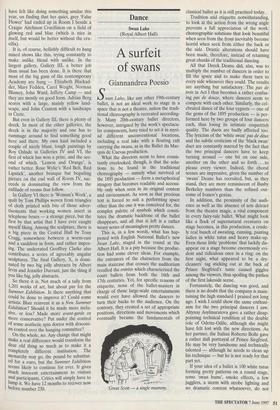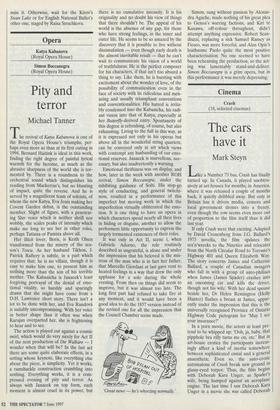Dance
Swan Lake (Royal Albert Hall)
A surfeit of swans
Giannandrea Poesio
Swan Lake, like any other 19th-century ballet, is not an ideal work to stage in a space that is not a theatre, unless the tradi- tional choreography is recreated according- ly. Many 20th-century ballet directors, however, intrigued by the work's spectacu- lar components, have tried to set it in myri- ad different unconventional locations, including a real lake with a floating raft carrying the swans, as in the Ballet du Mar- quis de Cuevas production. What the directors seem to have consis- tantly overlooked, though, is that the solu- tions to be found in the traditional choreography — namely what survived of the 1895 production — form a metaphorical imagery that becomes readable and accessi- ble only when seen in its original context and environment. As soon as that precious text is forced to suit a performing space other than the one it was conceived for, the complex palette of symbols which consti- tutes the dramatic backbone of the ballet disappears, and all that is left is a rather weary series of meaningless pretty dances. This is, in a few words, what has hap- pened with English National Ballet's new Swan Lake, staged in the round at the Albert Hall. It is a pity because the produc- tion had some clever ideas. For example, the entrances of the characters from the main staircase that crosses the auditorium recalled the entrées which characterised the court ballets from both the 16th and 17th centuries. Yet, for specific reasons of etiquette, none of the ballet-masters in charge of those large-scale entertainments would ever have allowed the dancers to turn their backs to the audience. On the contrary, they created a set of appropriate positions, directions and movements which eventually became the fundamentals of 'Great Scott — a single mummy.' classical ballet as it is still practised today.
Tradition and etiquette notwithstanding, to look at the action from the wrong angle prevents a full appreciation of the work: choreographic solutions that look beautiful when seen from the front inevitably become horrid when seen from either the back or the side. Drastic alterations should have been made, therefore, instead of retaining great chunks of the traditional dancing.
All that Derek Deane did, alas, was to multiply the number of dancers in order to fill the space and to make them turn to every side whenever they could. The results are anything but satisfactory. The pas de trois in Act I thus becomes a rather confus- ing pas de douze, where dancers seem to compete with each other. Similarly, the cel- ebrated dance of the four cygnets — one of the gems of the 1895 production — is per- formed here by two groups of four dancers each, thus losing its intimate coquettish quality. The duets are badly affected too. The lyricism of the 'white swan' pas de dewc and the subtle eroticism of the 'black swan' duet are constantly marred by the fact that the two principal dancers have to keep turning around — one bit on one side, another on the other and so forth ... to please every viewer. Indeed, the choral scenes are impressive, given the number of 'swans' Deane has recruited, but, as they stand, they are more reminiscent of Busby Berkeley numbers than the refined out- come of Ivanov's genius.
In addition, the proximity of the audi- ence as well as the absence of sets detract from the theatre magic, a vital component in every fairy-tale ballet. What might look like a flock of supernatural creatures on stage becomes, in this production, a crude- ly real bunch of sweating, running, panting ladies in white tutus and heavy make-up. Even those little 'problems' that luckily dis- appear on a stage become enormously evi- dent and ridiculous once in a ring: on the first night, what appeared to be a dry- cleaners' tag sticking out at the back of Prince Siegfried's tunic caused giggles among the viewers, thus spoiling the pathos of the first lakeside scene.
Fortunately, the dancing was good, and there is no doubt that the company is main- taining the high standard I praised not long ago. I wish I could show the same enthusi- asm for the two principal dancers I saw. Altynay Asylmuratova gave a rather disap- pointing technical rendition of the double role of Odette-Odile, although she might have felt lost with the new directions. As her partner, the Italian Roberto Bolle gave a rather dull portrayal of Prince Siegfried. He may be very handsome and technically talented — although he needs to clean up his technique — but he is not ready for that part yet.
If your idea of a ballet is 100 white tutus forming pretty patterns on a round stage, some 'swan bums', smoke effects, a few jugglers, a storm with strobe lighting and no dramatic content whatsoever, do not miss it. Otherwise, wait for the Kirov's Swan Lake or for English National Ballet's other one, staged by Raisa Struchkova.











































































 Previous page
Previous page